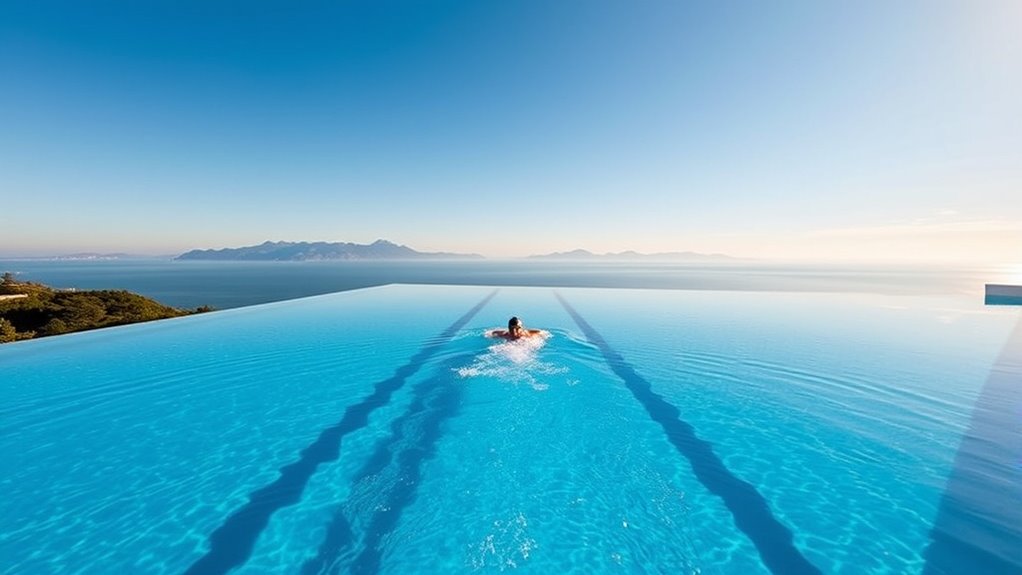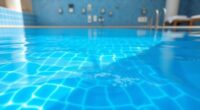To turn your infinity pool into a functional lap pool, start by evaluating the layout and available space, ensuring safety and access. Mark a clear, straight lane using floating dividers, and select slip-resistant materials like textured tiles for safety and durability. Incorporate visual cues to guide swimmers and add safety features like handrails and proper lighting. With the right design and materials, your infinity view can still be enjoyed during long, relaxing laps—discover more tips to perfect your pool.
Key Takeaways
- Assess the existing infinity pool’s size, depth, and structural integrity to determine feasibility for conversion into a lap pool.
- Redesign the pool’s layout to include a straight, narrow lane with clear boundaries for dedicated lap swimming.
- Install a separate, level water channel or extension with proper fencing to prevent overflow into the infinity edge.
- Use non-slip, durable materials for the lane surface, ensuring safety and ease of maintenance in the new section.
- Ensure unobstructed views are preserved by strategically positioning the lap lane and using transparent barriers if needed.
Assessing Your Infinity Pool’s Layout and Space
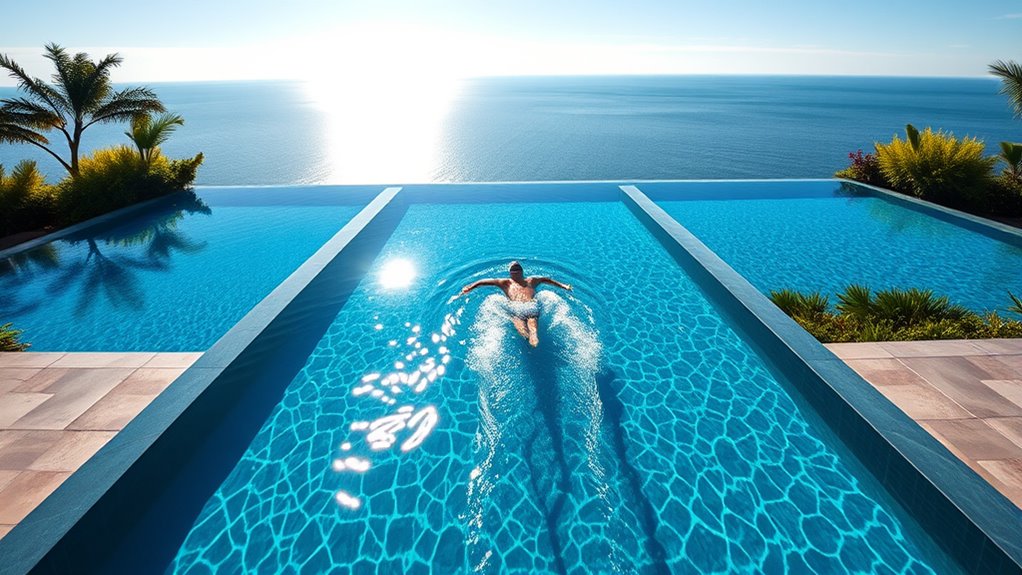
Before installing or renovating your infinity pool, it’s vital to evaluate its layout and available space carefully. You need to measure the area accurately, considering not just the pool’s size but also surrounding features like decks, landscaping, and access points. Think about how much room you’ll need for comfortable movement and maintenance. Check for any slope or uneven terrain that could affect pool installation or water flow. Consider sunlight exposure and wind direction, as these factors influence comfort and water evaporation. Ensuring there’s adequate space for safety barriers, steps, and equipment is also essential. Taking a detailed inventory of your space helps you plan a functional, aesthetically pleasing pool that meets your swimming needs while fitting seamlessly into your landscape. Additionally, understanding water quality considerations can help you select the right filtration and circulation systems for your pool.
Designing a Dedicated Lane for Lap Swimming
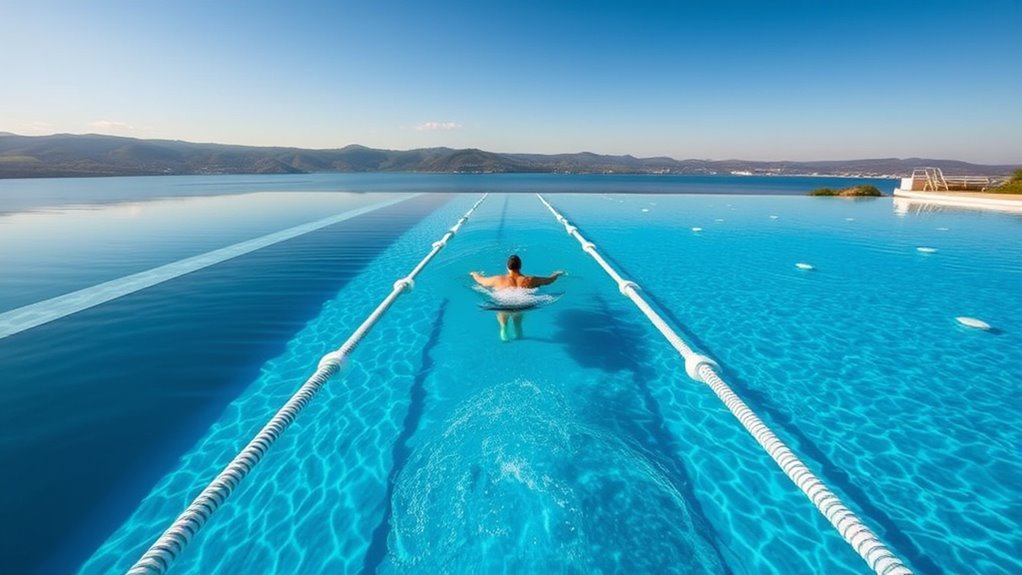
Creating a dedicated lane for lap swimming can considerably enhance your pool’s functionality and your overall swimming experience. To do this effectively, consider marking out a clear, straight path that runs the length of your pool. Use floating lane dividers or sleek boundary lines to keep swimmers in their zone and minimize turbulence. Think about adding visual cues, like contrasting tiles or color changes, to guide your swimming direction and improve focus.
- Install floating lane dividers or boundary lines
- Use contrasting colors or tiles for visual cues
- Ascertain the lane is straight and free of obstacles
This setup helps maintain a consistent swimming rhythm, reduces interference from other swimmers, and creates a dedicated space for effective workouts. With thoughtful design, your pool becomes both a relaxing view and a functional lap zone.
Choosing the Right Materials and Finishes
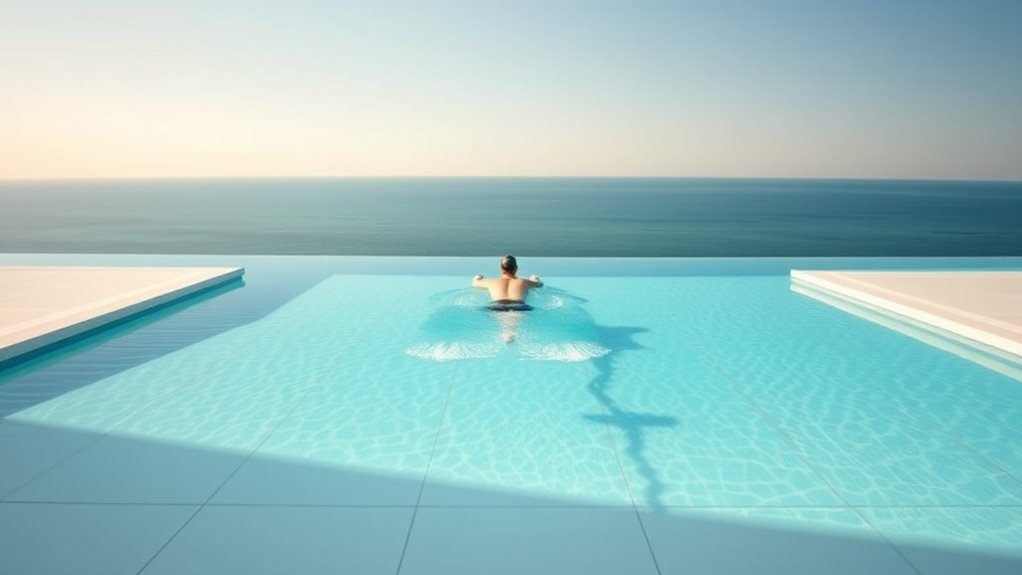
Selecting the appropriate materials and finishes for your lap lane is crucial to guarantee durability, safety, and visual appeal. Opt for slip-resistant surfaces like textured tiles or pebble finishes to prevent accidents. Choose high-quality, non-corrosive materials such as porcelain or ceramic tiles that withstand pool chemicals and weathering. Light-colored finishes can enhance visibility and create a sleek look, while darker shades hide stains better. Consider the pool’s overall aesthetic; modern materials like glass mosaics or matte finishes can add sophistication. Ensure the materials are easy to clean and maintain, reducing long-term upkeep. Properly sealed surfaces prevent algae buildup and water damage, extending the lifespan of your lap lane. Additionally, selecting a durable and authentic natural material can enhance the rustic charm and longevity of your pool area. Ultimately, selecting the right combination of durability, safety, and style will make your swimming experience more enjoyable.
Implementing Safety Features and Accessibility
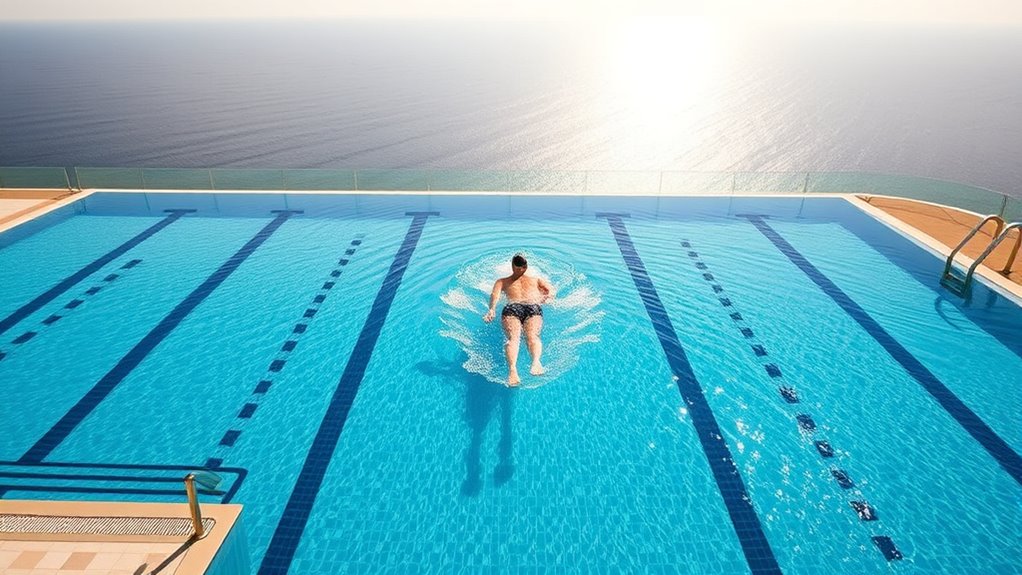
To guarantee your lap lane is safe and accessible for all users, you need to incorporate essential safety features such as clearly marked edges, non-slip surfaces, and proper lighting. These elements help prevent accidents and ensure everyone feels secure while swimming. You should also consider adding handrails at entry points and along the pool’s perimeter for stability. Ensuring easy access with ramps or wide steps makes it safer for people with mobility challenges. Additionally, install safety signage and emergency equipment nearby to address potential issues quickly. For example, you might include:
- Bright, visible edge markings
- Textured, slip-resistant flooring
- Adequate, well-distributed lighting
Implementing cost-effective production methods can also help ensure that safety features are consistently maintained without exceeding your budget. These measures create a safe, inclusive environment that encourages regular use and peace of mind.
Maintenance Tips for a Long-Lasting Lap Pool
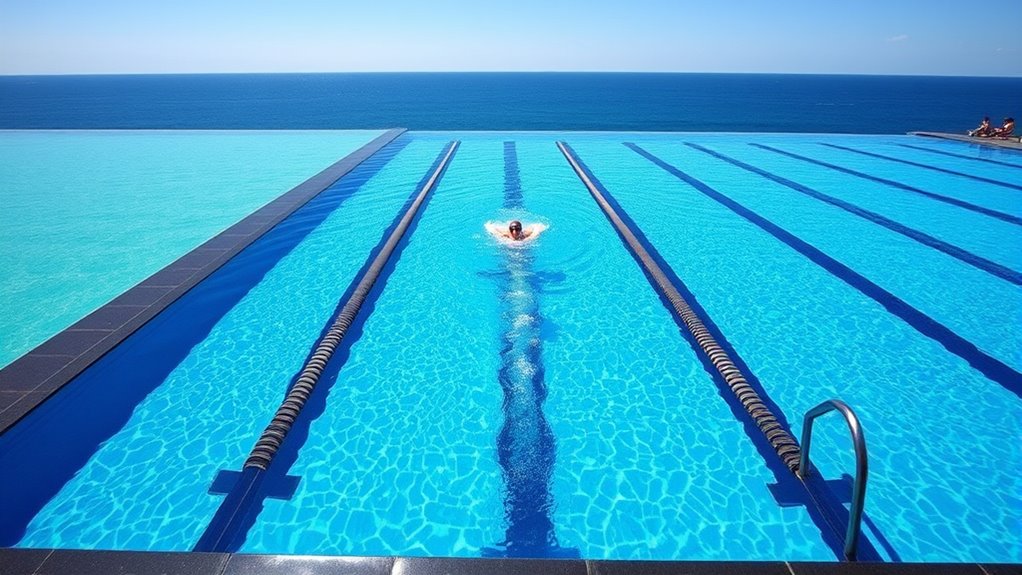
Regular maintenance is essential to keep your lap pool in top condition and extend its lifespan. Start by regularly checking and balancing the water chemistry, including pH, alkalinity, and chlorine levels. Proper chemical balance prevents algae growth, corrosion, and cloudy water. Clean the filter weekly to ensure proper circulation and filtration. Skim the surface daily to remove debris, leaves, and bugs. Vacuum the pool floor weekly to prevent dirt buildup. Check the pump and equipment for leaks or unusual noises, and address issues promptly. Cover your pool when not in use to reduce debris and evaporation. Regularly inspect the tiles, grout, and pool liner for wear or damage. Ensuring proper water quality is crucial for a safe and enjoyable swimming experience. Consistent upkeep not only prolongs your pool’s life but also guarantees a safe, inviting swimming environment.
Frequently Asked Questions
Can an Existing Infinity Pool Be Easily Converted Into a Lap Pool?
Yes, you can convert an existing infinity pool into a lap pool, but it requires careful planning. You’ll need to make certain the pool’s length and width are suitable for swimming laps, often involving reconfiguring the shape or adding lanes. You might also need to upgrade the filtration system for better water flow and consider resurfacing if necessary. Hiring a professional helps ensure a seamless and safe transformation.
What Are the Cost Implications of Transforming an Infinity Pool Into a Lap Pool?
Transforming your infinity pool into a lap pool is like remodeling a house—costs can vary widely. You’ll spend for new structural adjustments, specialized equipment, and possibly permits. Expect to pay anywhere from a few thousand to tens of thousands, depending on the pool’s size and complexity. Planning carefully and consulting professionals helps you manage expenses and ensures you get a sleek, functional lap pool without breaking the bank.
How Does the Water Circulation System Differ Between Infinity and Lap Pools?
You’ll find that the water circulation system in a lap pool is simpler, with dedicated skimmers and jets focused on efficient movement and filtration. In contrast, infinity pools rely on a more complex setup to maintain the seamless edge, often involving additional pumps and carefully designed overflow systems. This means lap pools prioritize consistent flow for swimming, while infinity pools emphasize aesthetics and water management.
Are There Specific Regulations or Permits Required for This Conversion?
You’ll need to check local building codes and zoning regulations before converting your infinity pool into a lap pool. Permits are typically required for structural changes, plumbing modifications, and electrical work. It’s best to consult your city or county’s permitting office early in the process. Hiring a licensed contractor familiar with pool conversions can help guarantee you meet all legal requirements and avoid potential fines or delays.
What Are the Best Times of Year to Undertake This Transformation?
You should plan the conversion during the off-season, typically fall or early spring, to avoid peak construction times and make certain quicker completion. Weather conditions are more predictable, reducing delays and making installation easier. Plus, contractors are usually more available, helping you get your new lap pool ready sooner. Don’t wait for summer—early planning ensures you enjoy your upgraded pool as soon as the weather warms up.
Conclusion
Transforming your infinity pool into a lap pool blends luxury with practicality, offering a serene swim with breathtaking views. While the sleek design provides elegance, it also demands regular upkeep. Balancing beauty and function means embracing both the aesthetic appeal and the safety features that keep your swim safe. Ultimately, turning your infinity pool into a lap pool marries breathtaking vistas with the discipline of fitness—proof that luxury and purpose can coexist beautifully.

